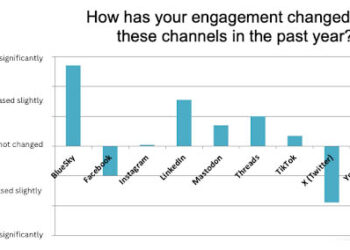
It’s no secret that the demographics of the work force are changing. Millennials are now the largest generational group in the work force and they act a bit differently than previous generations. Aside from generational shifts, economic pressures, time pressures, and social awareness impact the choices of most active workers today, including researchers, practitioners, social scientists and all of the audiences served by mission-driven professional organizations today. Although people almost always tend to seek out groups of common interest, social media has also allowed individuals to do that without the aid of a formal organizational structure.
As many of the Chefs note below, most membership organizations have attracted members based on both a cadre of individual benefits (publications, discounts to meetings, educational opportunities, grants, career recognition, etc.) as well as broader benefits to both their country of origin and even the world (supporting research, providing venues for experts to interact, policy creation, lobbying, etc.). But as people change the ways in which they work on a daily basis, evolve in how they value to the benefits offered, find new and effective ways to interact with their peers, and develop alternative methods for acting as a national or global group to work on issues, what is an association or society to do?
This month we asked the Chefs: What is the future of membership organizations? Does being a member still matter?
Charlie Rapple: I thought about your question in the context of my own memberships, past and present, which range from the Chartered Institute of Marketing to the Caravan Club. What I seek from them: personal development and recognition; inside information, connections and privileges; special deals and services. One aspect I immediately notice about my own behavior, which all membership organizations need to bear in mind, is that I may have considered in some detail whether or not to join, but I’m quite lazy about reviewing this decision, i.e. I allow most of my memberships to keep renewing themselves regardless of whether I feel that I am engaged with, or getting value from, the organization in question. Only if they prompt me to re-evaluate do they put themselves at risk of cancellation. (Be careful about assuming the long-term commitment of even your seemingly loyal members!) We can take this as an encouraging sign that being a member does still matter, enough that the benefits of membership are often not interrogated in detail. Both my personal decisions and my professional experience (helping to run a membership organization, UKSG, and advising several others on aspects of their brand and business development) reflect that members are happy to “support the community” even without deriving personal gain. On that basis, membership organizations should remain focused on facilitating and demonstrating progress towards community goals. This does not mean starting a community networking site, or setting out to compete on other fronts of that nature which stray too far from the expertise of the secretariat and members, into territories which are at least crowded and at worst hostile. It means ensuring events, publications, training and so on continue to reflect and drive the newest developments in the field; it means finding and encouraging rising stars; it means being strategically selective – “only doing what only you can do” – and making smart use of related tools and sources of intelligence to enable and optimize your efforts. While membership organizations are recognized as the breeding ground of new ideas, they will continue to have a future; membership will matter as long as that focus is clear, and the fee being asked in return is not inflated by investment outside areas of competence.
Rick Anderson: My response is going to be boring and predictable, I’m afraid: membership organizations (or more accurately, any particular membership organization) will persist to the exact degree that the cost of membership continues to provide members with value in proportion to cost, and relatively high value in comparison to cheaper or equally-costly alternatives. I truly apologize for the complete lack of original insight in that response, but the principle involved seems to me absolutely fundamental.
This does raise one important and complicating factor, though: the possibility that a membership organization might persist not because of the direct value it offers to members, but because of the value its members believe it creates in the wider world. This goes to the “soldiers and revolutionaries” model I proposed in a recent essay for the UKSG publication Insights — when making decisions about how to allocate our scarce resources, all of us (and all of our organizations) are trying to find the right balance between investments that directly benefit local constituencies and those that have a broader impact in the world. As individuals, we have to choose whether to buy another $50 worth of clothing or make a $50 contribution to National Public Radio; as libraries, we have to decide whether to spend $5,000 on a database in support of our institutions’ research priorities or to spend those $5,000 on membership in an open access publishing initiative of some kind. These are options that have emerged only quite recently, and they introduce another dimension of decision-making complexity that will itself have an impact on the future of membership organizations. How that complexity will play out is something I wouldn’t try to predict at this point.
Joe Esposito: The future of professional societies is among the more vexing questions in scholarly communications. In my experience membership is still valued, but not by everyone and not to the degree that many would want. Of course the problem with saying something like this is that no one measured membership engagement in the past in a way that we could compare to today, so we may be decrying a decline in membership involvement that is mostly imaginary.
As to the future, though, I think someone will see in this a business opportunity. The primary candidates are the largest commercial publishers, who continue to scoop up journals programs from professional societies. It seems probable that the services that these publishers provide to the societies will grow; some will say that they will grow insidiously. Since, protests to the contrary, librarians like to purchase big packages from big publishers, the roll-up will continue, with large publishers using enhanced membership services to lock in the societies to their programs. This will not mean that Elsevier, Wiley, and their ilk will “own” societies any more than they “own” the society journals they publish. But they will have privileged access to and control of these societies.
Michael Clarke: As the world becomes more complex and the nature of work (its skills and technologies) continue to change, professional associations will continue to have a role (in some cases, an increased role) in supporting their members with the knowledge, skills, and networks to navigate the changing workplace and remain successful. The challenge for associations is in re-tuning their financial models to support today’s realities. Many professional associations have relied on two pillars in attracting members: meetings and publications. While meetings remain vibrant (albeit mercurial) revenue streams, publications are an increasingly weak link in the membership value equation. This is not because publications have ceased to be of interest to members – quite the contrary according to nearly every membership survey I’ve seen. The challenge is that many publications, especially journals, are accessible to members via channels outside of their membership benefits. With the proliferation of site licensing, many members have access to association journals through their institutional affiliation. Open access journals provide a similar quandary for associations. So while members continue to value journals as sources of information, they are increasingly of less value as member benefits. In order to continue provide a compelling reason to retain and grow their membership, it is incumbent on associations to develop products and services of value to members beyond journals. These might include educational products, databases, certifications, newsletters, training, or other activities relevant to their respective specialty. Some associations are far ahead on this with many valued member benefits beyond journals. For other it will be a central and increasingly urgent challenge.
Alice Meadows: This is a tough one to answer because on the one hand, being a member of a group is an intrinsic part of being human so, by that token, it’s hard to imagine all membership organizations disappearing altogether. On the other hand, the digital revolution is completely transforming the sorts of groups we belong to and how we interact within them. And many (most) traditional membership organizations have yet to catch up with the likes of Facebook, Reddit, and others who are leading this transformation. If the results of Wiley’s recent membership survey are anything to go by, the traditional association is still alive and kicking at present, but there are signs that many are getting less and less successful at recruiting and retaining younger members — amazingly, often for the simple reason that no one invited them to join! In addition many societies’ revenues are starting to get squeezed by pressure on their traditional income from journals, conferences, and membership dues. Challenging times for sure… However, being an eternal optimist — and knowing a number of very smart, forward-looking association executives (including some of my fellow Chefs) who already have this challenge firmly in their sights – I’m hopeful that membership organizations won’t just survive but will thrive in the future. But not necessarily in the shape or form we now know them, and very likely with less money to support their communities in the same ways as they do today.
Robert Harington: I work for a membership organization, so I may be just a little biased. Then again this is a question that we are indeed asking ourselves. At the American Mathematical Society (AMS) we are in the midst of strategic planning across the organization, from membership issues to meetings, programs and publishing. It is an exhilarating time, and one of the key issues is that of defining the role of a membership organization such as AMS. We have over 28,000 members ranging from student to the most accomplished mathematician. The numbers are falling and aging. Perhaps there is wider societal question we need to address before we even begin to look at the AMS. “In a World” (I love saying this in a deep and booming voice) where the next generation of young academics are those who will fill the ranks of membership, what does the notion of membership mean? We are talking about a cultural evolution of the whole idea of belonging to a community. In many respects we see a generation that has entirely different and more diffuse notions of community, exhibited in voting patterns, the individualization of community through social media, the virtualization of groups through online gaming and the stark reality of considering what is in it for me if I join a society. It is no longer just something you do as part of your career path.
Christine Stevens (Associate Executive Director of Membership, Meetings and Professional Services at the American Mathematical Society) says “My favorite perspective on “associations in civil life” is that of Alexis de Tocqueville, who noted that “Americans of all ages, all conditions, all minds constantly unite”, and felt that this was one the great strengths of American democracy. As he put it, “There is nothing, according to me, that deserves more to attract our regard than the intellectual and moral associations of America. … In democratic countries the science of association is the mother science; the progress of all the others depends on the progress of that one.” In my opinion, de Tocqueville got it exactly right. It is only by associating with each other that mathematicians can fulfill the AMS’s mission to “further the interests of mathematical research and scholarship.” The trick, of course, is to convince a new generation of emerging mathematicians to adopt this view. Partly with that in mind, we are currently seeking to fill the newly established position of Director of Membership Development.”
Ann Michael: Most membership groups are finding that the average age of their membership is increasing, but that mid to late career professionals still represent the lion’s share of their dues revenue. They’re faced with the issue: How do we retain our current membership while attracting new members at earlier career stages? There are often incongruities between the values of members at different career stages. For example, although this might be changing, historically older members on average put a higher value on print publications than younger members have.
However, sometimes seemingly conflicting needs are actually complementary. For example, early career members often highly value opportunities for career growth and professional mentoring, education, and guidance. Some organizations are trying to play “match maker” – connecting the more senior, experienced members (who are at a career stage where they want to “give back”) with the the younger members. This can be a mutually rewarding experience where the more established professionals not only support their professional community through mentorship, but also get to stay in tune with the minds that will shape their profession going forward. The early career professionals are able to tap the expertise and insight of someone knowledgeable in their field.
At a macro level, there are two significant trends working together that I feel will significantly contribute to shaping the future of membership and the effectiveness and vibrancy of membership organizations. The first is external: focusing on the customer. Increasingly, membership groups are actively seeking to understand their membership at a detailed, segmented level and to shape their organization to be meaningful to these members. This does involve rethinking membership – sometimes substantially. It also represents a shift in their thinking from simply adding more “stuff” to the membership benefit list (usually involving more cost to the organization without a supporting revenue stream) to considering more customizable membership options. The second trend we’ve likely all been witnessing is that many organizations focused on membership are making a conscious effort to break down their internal silos, to bring the entire weight of their organizations to bear on the issues facing their members and their professional environment. Together, these trends will allow for a member to have a full view of the activities and accomplishments of an organization, for organizations to more effectively serve the needs of their members and constituencies, and for organizations to maintain a full view of their members, what they value, and how they engage, based on data from all activities (and maybe even from outside of their own four walls). How exciting is that!
What are your opinions and observations? What do you think lies in the future for membership organizations? Will they evolve or become less and less relevant?
Discussion
7 Thoughts on "Ask The Chefs: What Is The Future of Membership Organizations? Does Being a Member Still Matter?"
If the wall between being a member is cost of membership why have dues? The vast majority of income comes from publications, meetings, and education. The costs incurred are those supporting those activities. Thus, the argument can be made to decrease those costs and this can be done by farming them out and concomitantly reducing staff which is overhead. The number of members will go up and the costs will go down and the society will increase membership and prosper.
Of course that is if the sole goal is to have more members.
I think many societies will expand membership and do very well in this technological world. At least those which figure out just what members want. Members and potential members will pay for something they want. Additionally, those societies which have publishing partners should task those partners and under their tutelage create new journals, books, e products and other products which will generate more revenue.
Hi Harvey, I’d be concerned that removing the dues would reduce people’s sense of *needing* to get value out of their membership, and therefore risk disconnecting them even more (reference my own experience above, where some of my memberships are sufficiently cheap that I let them roll without really paying attention to what they offer, or indeed, what I could offer to that organisation.) It ties into your second point – if what members want = what members value, then making it free could undermine the credibility of or the engagement with what is being offered?
I’m curious how the economic state of early career academics fits into this discussion? Given that early career academics often have a lot of debt, tenure-track positions are decreasing, and adjunct positions often have little or no institutional support for things like membership dues, it’s often difficult to justify the cost of membership in an academic organization. Or, put another what, whither the society in an age of precarity?
The $64,000 (or million dollar) question I keep hearing is “how do we get the millennials and how do we convert student members to full members?” The first step to answering this question is to actually ASK them! A recent survey showed that most are literally waiting to be asked to participate in some way. YES! So ask them to participate. Why is that so hard? Well the reason that is difficult is that most participation currently offered by associations centers on expertise. Committees develop technical standards, standards of care, guidelines, etc. These are important (and profitable) and can’t be left to someone with only 2 years of post-college experience. Some associations have trouble with the “old boys club” whereby you have to know someone to get in the door. Again, newer/younger professionals don’t have that network. But are there not creative solutions to this problem?
I attended a session at CESSE about volunteerism and it was all about task volunteering and micro volunteering–offering small, short term, perhaps local, opportunities for people to get engaged. This will no doubt require work by the organization to pull together but may be a great way to include people at all levels of their career.
You’re right that younger members may not have the expertise to advise on eg standards of care etc Angela but they do have expertise in other areas that older members may not, such as technology, social media. Like you I believe that all menbership organizations would benefit from finding ways for their younger members to participate as fully as the older ones – both because that will ensure that their committees reflect the full breadth of their memberahip and because it will solve that waiting to be asked problem.



